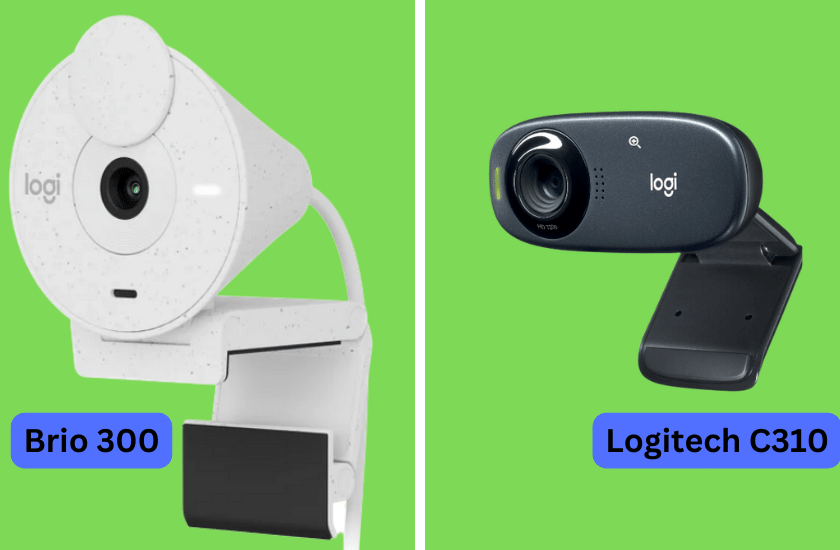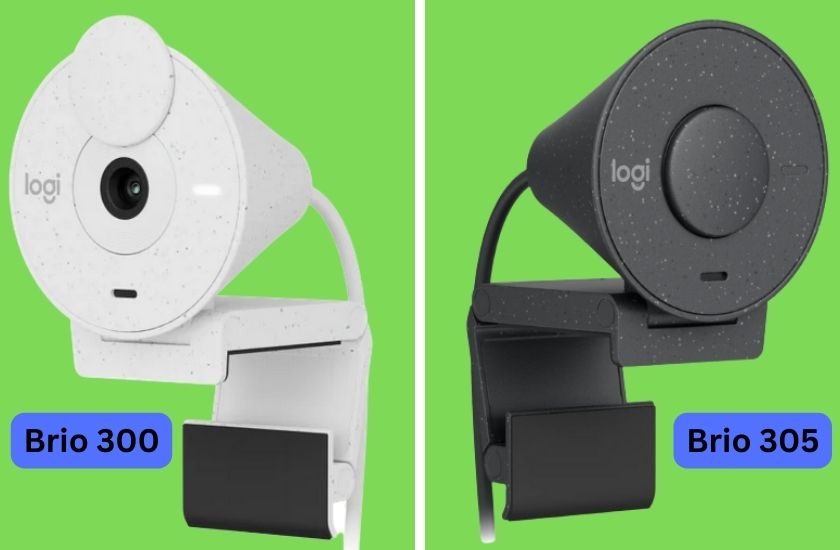Buying through links in our article may earn us a commission. This does not impact our editorial independence.
Razer Kiyo Pro vs Logitech Brio
As someone who spends a lot of time video conferencing and creating content, having a high-quality webcam is crucial. Recently, I’ve been comparing the Razer Kiyo Pro and the Logitech Brio to see which one is the better option. Both cameras have impressive features, but which one comes out on top? In this article, I’ll be breaking down the design, video quality, field of view, low light performance, autofocus, audio quality, connectivity, software, features, price, and pros and cons of each camera to help you make an informed decision.
Design and Build Quality Comparison
The Razer Kiyo Pro has a sleek and modern design with a black finish and a metal body. It’s easy to adjust the angle of the camera, and it feels sturdy and well-built. The Logitech Brio has a similar design, with a black finish and a metal body, but it’s a bit bulkier than the Razer Kiyo Pro. The Brio also has a clip that allows you to attach it to your monitor or laptop.
Both cameras have a built-in privacy shutter, which is a nice touch. However, the Razer Kiyo Pro’s shutter is a bit smoother and more responsive than the Brio’s. Overall, the build quality of both cameras is excellent, but the Razer Kiyo Pro edges out the Logitech Brio in terms of design and ease of use.
Score: Razer Kiyo Pro – 4.5/5, Logitech Brio – 4/5
Video Quality and Resolution Comparison
When it comes to video quality, both cameras are impressive. The Razer Kiyo Pro has a maximum resolution of 1080p at 60fps, while the Logitech Brio can go up to 4K at 30fps. However, the Razer Kiyo Pro has better image quality with sharper and more vibrant colors. The Brio’s 4K resolution is nice, but it’s not necessary for most video conferencing or content creation purposes.
Both cameras have HDR support, which helps to improve the contrast and color accuracy of the image. However, the Razer Kiyo Pro’s HDR is more effective and less prone to over-saturation than the Brio’s. Overall, the Razer Kiyo Pro wins when it comes to video quality and resolution.
Score: Razer Kiyo Pro – 5/5, Logitech Brio – 4/5
Field of View: Razer Kiyo Pro vs Logitech Brio
The field of view (FOV) is an important factor to consider when choosing a webcam. The Razer Kiyo Pro has a FOV of 103 degrees, while the Logitech Brio has a FOV of 90 degrees. This means that the Razer Kiyo Pro captures more of the room and allows for a wider angle of view.
However, the Logitech Brio has a feature called "RightLight 3," which automatically adjusts the brightness and contrast of the image based on the lighting conditions in the room. This can be helpful in situations where the lighting is less than ideal. Overall, the Razer Kiyo Pro wins when it comes to FOV, but the Logitech Brio’s RightLight 3 feature is worth considering.
Score: Razer Kiyo Pro – 4.5/5, Logitech Brio – 4/5
Low Light Performance Comparison
Both cameras perform well in low light conditions, but the Razer Kiyo Pro has the edge. It has a larger sensor and a wider aperture, which allows it to capture more light and produce a brighter image. The Logitech Brio also has a decent low light performance, but it tends to produce more noise in darker conditions.
Both cameras have a feature called "noise reduction," which helps to reduce the amount of graininess in the image. However, the Razer Kiyo Pro’s noise reduction is more effective and less aggressive than the Brio’s. Overall, the Razer Kiyo Pro wins when it comes to low light performance.
Score: Razer Kiyo Pro – 5/5, Logitech Brio – 4/5
Autofocus and Manual Focus Comparison
Autofocus is an important feature to have in a webcam, especially if you’re moving around or changing your distance from the camera. The Razer Kiyo Pro has a fast and accurate autofocus system that works well in most situations. However, it doesn’t have a manual focus option, which can be a drawback if you need more control over the image.
The Logitech Brio has both autofocus and manual focus options, which gives you more flexibility when it comes to adjusting the image. The autofocus is a bit slower than the Razer Kiyo Pro’s, but it’s still effective. Overall, the Logitech Brio wins when it comes to autofocus and manual focus options.
Score: Razer Kiyo Pro – 4/5, Logitech Brio – 4.5/5
Audio Quality Comparison
Both cameras have built-in microphones that produce decent audio quality. However, if you’re serious about audio, you’ll want to invest in a separate microphone. The Razer Kiyo Pro’s microphone is slightly better than the Logitech Brio’s in terms of clarity and noise reduction. However, it’s still not as good as a dedicated microphone.
Overall, both cameras perform well in terms of audio quality, but if you’re looking for professional-grade audio, you’ll want to look elsewhere.
Score: Razer Kiyo Pro – 3.5/5, Logitech Brio – 3/5
Connectivity and Compatibility Comparison
Both cameras are compatible with Windows and Mac operating systems, and they connect via USB-A or USB-C. The Razer Kiyo Pro also has a HDMI output, which can be useful if you want to connect it to an external monitor or capture card. However, it doesn’t have a built-in USB hub like the Logitech Brio does.
The Logitech Brio also has a USB-C connection option, which is helpful if your computer has a USB-C port. Overall, both cameras are easy to connect and compatible with most systems, but the Razer Kiyo Pro has a slight edge due to its HDMI output.
Score: Razer Kiyo Pro – 4/5, Logitech Brio – 4/5
Software and Features Comparison
Both cameras come with their own software that allows you to adjust the settings and customize the image. The Razer Kiyo Pro’s software is simple and easy to use, with options for adjusting the brightness, contrast, saturation, and exposure. It also has a feature called "Smart Frame," which automatically adjusts the camera angle to keep you centered in the frame.
The Logitech Brio’s software is more comprehensive, with options for adjusting the image quality, autofocus, and manual focus. It also has a feature called "Background Replacement," which allows you to replace your background with a virtual one. However, the software can be a bit overwhelming and complicated to use.
Overall, both cameras have solid software and features, but the Razer Kiyo Pro’s software is more user-friendly.
Score: Razer Kiyo Pro – 4.5/5, Logitech Brio – 4/5
Price Comparison: Razer Kiyo Pro vs Logitech Brio
The Razer Kiyo Pro is priced at around $200, while the Logitech Brio is priced at around $180. Both cameras are relatively expensive, but the Razer Kiyo Pro is slightly more expensive due to its superior image quality and design.
Score: Razer Kiyo Pro – 3.5/5, Logitech Brio – 4/5
Pros and Cons: Razer Kiyo Pro vs Logitech Brio
Razer Kiyo Pro Pros:
- Superior image quality
- Sleek and modern design
- Easy to adjust camera angle
Razer Kiyo Pro Cons:
- No manual focus option
- Slightly more expensive than the Logitech Brio
Logitech Brio Pros:
- 4K resolution option
- Autofocus and manual focus options
- Built-in USB hub
Logitech Brio Cons:
- Bulkier design
- Complicated software
Conclusion: Which Webcam is Right for You?
Both the Razer Kiyo Pro and the Logitech Brio are excellent webcams with impressive features. However, if you’re looking for the best image quality and design, the Razer Kiyo Pro is the way to go. If you need a webcam with 4K resolution or manual focus options, the Logitech Brio is a solid choice. Ultimately, it comes down to your specific needs and preferences.
Emily Rodriguez
With a background in consumer research and product testing, Emily Rodriguez a wealth of knowledge and experience to the GoodvsBetter.com team. He is dedicated to helping readers make informed decisions and find the best options for their needs and budget.




